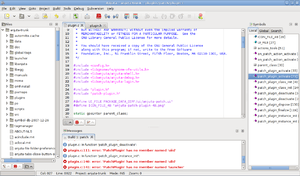Anjuta
 | |
|
Screenshot  Anjuta in action | |
| Original author(s) | Naba Kumar |
|---|---|
| Developer(s) | Johannes Schmid, Sebastien Granjoux, Massimo Cora', James Liggett and others |
| Initial release | December 27, 1999[1] |
| Stable release | 3.22.0[2] (September 18, 2016[2]) [±] |
| Preview release | 3.25.91[2] (August 20, 2017[2]) [±] |
| Repository |
|
| Written in | C (GTK+) |
| Operating system | Unix-like |
| Platform | GNOME |
| Available in | 19 languages[3] |
| Type | Integrated development environment |
| License | GNU General Public License[4] |
| Website |
anjuta |
Anjuta is an integrated development environment written for the GNOME project.[5] It has support for the C,[6] C++,[6] and syntax highlighting for Java, JavaScript, Python and Vala programming languages. It comes standard on base installation DVDs of major Linux distributions such as Ubuntu,[7] openSUSE,[7] Fedora,[7] and Mandriva Linux (amongst others).
Anjuta DevStudio (2.x)
| Stable release |
3.6.0
/ October 26, 2012 |
|---|---|
| Repository |
|
| Website |
github |
The goal of Anjuta DevStudio is to provide a customizable and extensible IDE framework and at the same time provide implementations of common development tools. Libanjuta is the framework that realizes the Anjuta IDE plugin framework and Anjuta DevStudio realizes many of the common development plugins.
It integrates programming tools such as the Glade Interface Designer and the Devhelp API help browser.
Features
Anjuta features:
- an interactive debugger built over GDB and integrated compiler[8]
- a source code editor with source browsing,
- code completion and syntax highlighting,
- project management,[8]
- application wizards.[8]
- version control system integration
Reception
The German magazine LinuxUser recognized Anjuta 1.0.0 (released in 2002) as a good step to increase the number of native GNOME/GTK applications, stating that the application has a very intuitive GUI and new useful features.[9]
In April 2017, Anjuta was removed from the OpenBSD ports tree, with stagnation of development and existence of alternatives cited as reasons.[10]
See also
References
- ↑ "Anjuta DevStudio: Integrated Development Environment". Projects.gnome.org. 1999-12-27. Retrieved 2010-05-12.
- 1 2 3 4 "Index of /sources/anjuta". Retrieved 2017-09-09.
- ↑ Naba Kumar. "Module Statistics: anjuta". L10n.gnome.org. Retrieved 2010-05-17.
- ↑ Schürmann, Tim (2002). "schweizer messer - Entwicklungsumgebungen im Vergleich". LinuxUser (in German) (2). Retrieved 23 March 2012.
- ↑ Stiebert, Julius (12 March 2008). "Gnome 2.22 mit Desktop-Effekten" (in German). Golem.de. Retrieved 23 February 2012.
- 1 2 Kleijn, Alexandra (12 March 2008). "Gnome 2.22 - Das neue Halbjahres-Release der Desktop-Umgebung" (in German). Heinz Heise. Retrieved 23 February 2012.
- 1 2 3 Thoma, Jörg (8 April 2011). "Tutorials für Entwickler" (in German). Golem.de. Retrieved 23 February 2012.
- 1 2 3 Ganslandt, Björn (2001). "GNOME Fifth-Toe 1.4". LinuxUser (in German) (5). Retrieved 23 March 2012.
- ↑ "News und Programme rund um Gnome". LinuxUser (in German) (1). 2003. Retrieved 23 March 2012.
- ↑ Adriaanse, Jasper Lievisse (17 April 2017). "remove anjuta". Retrieved 18 April 2017.
Further reading
- Schulz, Hajo (2002). "Selbst geschneidert — Software-Kollektion für Entwickler". c't (in German) (13): 150.
External links
